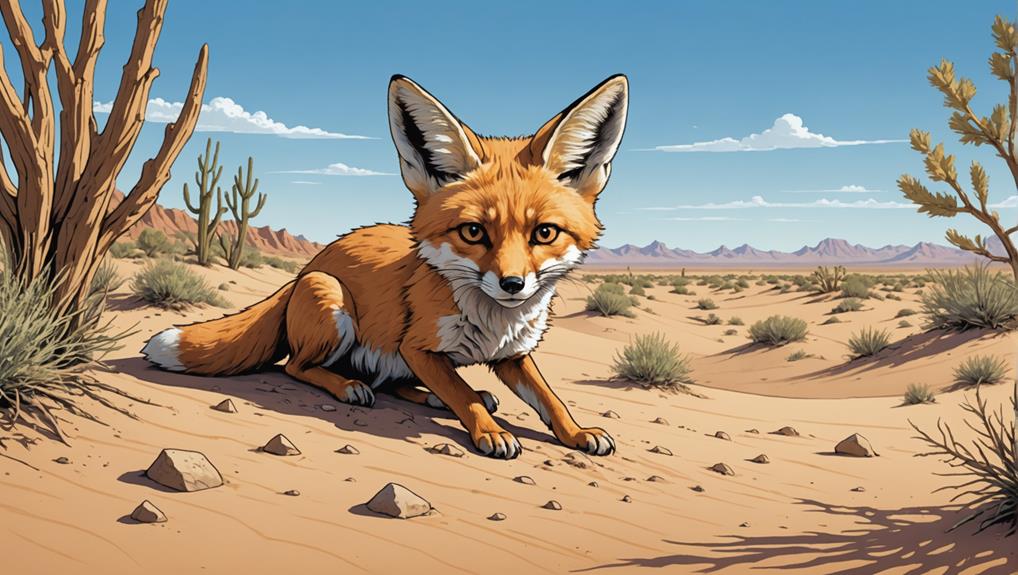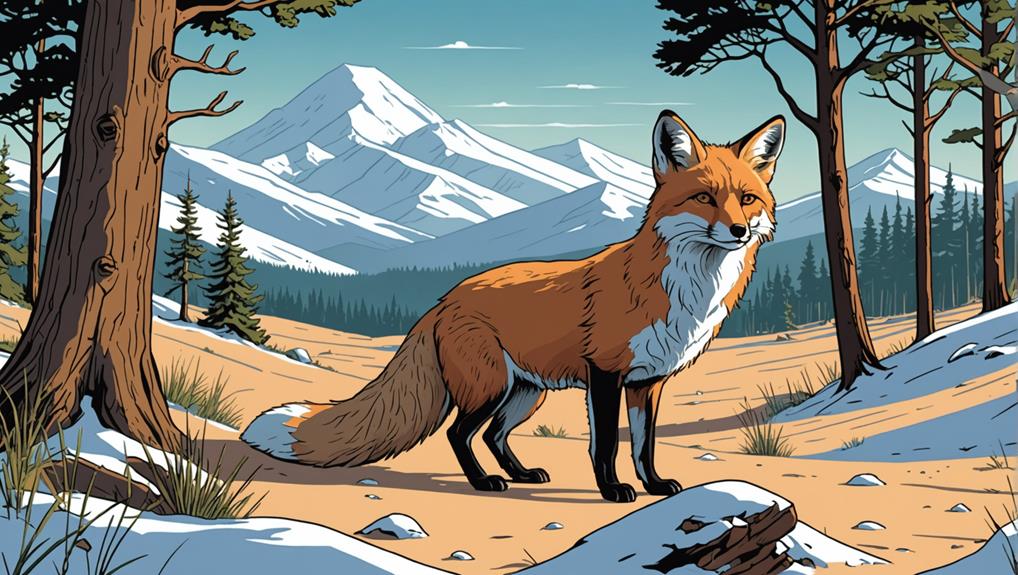Foxes are incredible animals, with about 22 species roaming the globe. You've got the adaptable red fox, hanging out in forests and urban areas, and the Arctic fox, a hardy survivor from frozen tundras. Then there's the fennec fox, sporting big ears in the Sahara, the kit fox thriving in American deserts, and the gray fox that surprises by climbing trees! Don't forget the swift fox, darting through the Great Plains. Each of these clever creatures plays a unique role in their ecosystems, highlighting the importance of conservation efforts. Want to explore their quirky behaviors and habitats more?
Contents
Overview of Fox Diversity
Exploring the world of foxes reveals a fascinating diversity among approximately 22 recognized species. These clever canines come in all shapes and sizes, each uniquely adapted to their habitats. For instance, the red fox, the largest of the true foxes, thrives in various environments across North America, Europe, and beyond.
Meanwhile, the gray fox impressively climbs trees, making its home in wooded areas of eastern and southwestern North America.
Then there's the fennec fox, the smallest of the bunch, which has a knack for surviving the scorching North African deserts. With its oversized ears, it's perfectly suited for nocturnal adventures and keeping cool.
In the icy realms of Alaska and northern Canada, the arctic fox showcases its resilience with thick fur to battle the brutal cold.
Don't forget the kit fox and swift fox, both of which have adapted to American deserts and prairies, showcasing the amazing variety within the fox family.
This diversity isn't just fascinating; it highlights the importance of conservation efforts. As you learn about these remarkable species, you'll appreciate their roles in their ecosystems and feel inspired to help protect them.
Red Fox Distribution
The red fox (*Vulpes vulpes*) stands out among its relatives due to its extensive distribution across various continents.
You'll find these clever creatures in North America, Europe, Asia, and even parts of northern Africa, but they're notably absent in southern California, Arizona, and central Texas. Isn't it fascinating how adaptable the red fox is? They thrive in diverse habitats, from forests and grasslands to deserts and urban areas.
In fact, red foxes often make their homes near human settlements, frequenting parks and agricultural fields. This adaptability is key to their success.
With about 47 recognized subspecies tailored to different environments, the red fox showcases impressive versatility. However, their distribution isn't without challenges; competition from coyotes and wolves in the eastern U.S. has made these charming canids less common in certain areas.
Arctic Fox Habitats

Arctic foxes frequently inhabit some of the most extreme environments on Earth, primarily found in the Arctic regions of northern Canada, Alaska, Greenland, Iceland, and parts of Russia.
These clever little creatures are true survivors, thriving in tundra ecosystems filled with permafrost and low vegetation. Their ability to adapt to climate extremes is remarkable. With a thick coat that insulates them against harsh cold, they change color from brown in summer to white in winter, blending seamlessly into their snowy surroundings.
Dens play a crucial role in their lives, offering shelter and safety from predators like polar bears. You might think of these dens as cozy homes, dug into snow or earth, where they breed and raise their young.
Arctic foxes are opportunistic feeders, scavenging on carrion or hunting small mammals like lemmings. It's a tough life, but their cleverness keeps them going.
Fennec Fox Adaptations
Let's take a closer look at the fennec fox and its incredible adaptations that help it thrive in the scorching desert.
With those large ears, it not only looks adorable but also hears every tiny rustle around it, making nighttime hunting a breeze.
Plus, its unique diet and foraging strategies ensure it stays well-fed while dodging the heat—talk about a clever little survivor!
Unique Ear Structure
Known for their distinctive adaptations, fennec foxes (*Vulpes zerda*) showcase a remarkable ear structure that plays a crucial role in their survival.
These adorable little foxes have ears that can grow up to six inches long! Imagine that—your ears being as long as your forearm! This unique physical characteristic isn't just for show; it helps them thrive in their desert habitat.
The large ears of the fennec fox aren't just impressive; they serve two vital functions.
First, they enhance hearing acuity, allowing these foxes to detect prey and predators from far away. It's like having built-in super-hearing in the vast, sandy landscape!
Second, those ears help with thermoregulation. Thanks to their unique vascular structure, blood cools as it flows through their ears, preventing overheating in the scorching desert sun.
Nocturnal Hunting Behavior
How do fennec foxes thrive in the harsh conditions of the North African desert? These remarkable little creatures have mastered the art of nocturnal hunting. By venturing out at night, they avoid the punishing daytime heat, conserving both water and energy. Their large ears not only help cool them down but also allow them to hear even the faintest sounds of prey, like small mammals and insects hiding beneath the sand.
Here's a closer look at their nocturnal behavior:
| Adaptation | Function | Benefit |
|---|---|---|
| Large ears | Dissipates heat and enhances hearing | Locates prey effectively |
| Agility | Quick and nimble movements | Evades predators |
| Pouncing techniques | Similar to other nocturnal hunters | Catches prey by surprise |
| Sensitive nose | Detects scents in the dark | Identifies food sources |
| Nocturnal lifestyle | Active during cooler night hours | Reduces water loss |
With their agility and keen senses, fennec foxes have adapted perfectly to their desert home. They're not just cute; they're survival experts! So next time you think of desert life, remember the clever fennec fox, gracefully navigating the sands under the stars.
Diet and Foraging Strategies
Thriving in the challenging environment of the North African desert, fennec foxes exhibit remarkable dietary flexibility and innovative foraging strategies.
These little guys are omnivorous, munching on a diet that includes insects, small mammals, and some fruits. Their adaptability shines in the desert habitat, where food can be scarce, and they've mastered the art of foraging under the cover of night.
With their large ears, fennec foxes not only keep cool but also enhance their hearing, allowing them to pinpoint prey hiding beneath the sand. As nocturnal hunters, they take full advantage of the cooler temperatures, making their nighttime adventures a breeze.
Plus, they show off their cleverness with caching behavior, storing extra food in underground burrows for when they get peckish later.
What's impressive is how fennec foxes can go long periods without water, getting hydration from the moisture in their food.
Kit Fox Behavior

When you think about kit foxes, picture these little guys zipping around the desert under the moonlight, hunting for their next meal.
They're not just solo adventurers; they live in family groups and hang out in cozy communal dens, making their social lives quite the topic of conversation.
With their impressive speed and clever foraging habits, these nocturnal hunters certainly know how to make the most of their arid home!
Nocturnal Hunting Habits
Although kit foxes are primarily nocturnal, their hunting habits reveal a fascinating adaptation to their arid environments. These clever little canines thrive in the desert, foraging at night to dodge the sweltering daytime heat. With their keen hearing, they pick up the faintest sounds of small mammals scurrying around, making them agile hunters.
When you think about kit foxes, consider these remarkable traits:
- They often employ a unique pouncing technique to catch their prey.
- Their diet mainly includes small nocturnal mammals, insects, and even some fruits.
- Adaptations like high temperature tolerance help them survive in their habitats.
- They primarily roam the open plains and desert areas of the southwestern U.S. and northern Mexico.
- Kit foxes are masters of stealth, blending into the night as they search for food.
These nocturnal foragers are an essential part of the desert ecosystem, helping control the populations of their prey.
Social Structure Dynamics
Kit foxes showcase intriguing social structures that contrast with their solitary hunting habits.
While these clever little canids often roam alone, they do form loose family groups during the breeding season. Isn't that fascinating?
Female kit foxes are the queens of their territories, fiercely protecting them as they raise their young. Males, on the other hand, are the adventurous types; they leave their natal homes to carve out new territories, which means they rarely share space with females.
Communication is key in their world. They use vocalizations not just for mating calls but also to alert each other about potential dangers.
Environmental conditions and resource availability play a big role in shaping their behavior and group dynamics. When food is abundant, you might see a few kit foxes coming together, but in tougher times, they revert to their solitary ways.
Diet and Foraging Behavior
Typically, kit foxes rely on a diverse diet that includes small mammals, insects, and even some vegetation. Their omnivorous diet showcases their adaptability, allowing them to thrive in arid environments. When you think about it, these little guys are like nature's scavengers, making sure nothing goes to waste!
Here's a glimpse of what makes up their diet:
- Small mammals, like rodents and rabbits
- Insects and other invertebrates
- Seasonal fruits and plants
- Prairie dogs (when they can catch them!)
- Cached food during lean times
Their nocturnal foraging behavior is fascinating. Kit foxes often use their keen hearing to detect the slightest movement, which is crucial for spotting hidden prey.
They've a unique hunting strategy called "pouncing," where they leap into the air to surprise unsuspecting critters. This clever adaptation helps them find meals even when food is scarce.
Understanding the diet and foraging behavior of kit foxes is vital for their conservation status. These little foxes play an essential role in their ecosystem, helping control rodent populations and ensuring a balanced habitat.
Gray Fox Ecosystem Role
The gray fox (*Urocyon cinereoargenteus*) plays a crucial role in its ecosystem, acting as both a predator and prey. These clever little creatures help control populations of small mammals, birds, and insects, ensuring that nature stays in balance.
But they're not just about hunting; gray foxes are also a tasty snack for larger predators, making them a vital part of the food web.
What's really fascinating is their adaptability! Gray foxes can thrive in various habitats, from lush forests to urban areas. They're great climbers, which adds a unique twist to their foraging habits. Climbing trees helps them escape danger and contributes to biodiversity.
Their diet is pretty varied, too. By munching on fruits, they assist in seed dispersal, promoting plant diversity everywhere they roam.
Plus, when they dig dens in abandoned burrows or hollows, they help with nutrient cycling—making the soil healthier for other plants and animals.
In short, gray foxes are like nature's little helpers, quietly supporting the ecosystem while keeping things lively. They may be small, but their impact is significant, and that's something to appreciate!
Conservation Efforts for Foxes

Gray foxes, along with other fox species, face various challenges that threaten their populations and habitats.
Thankfully, many conservation efforts are in place to help them thrive. These initiatives focus on habitat protection and breeding programs for endangered species like the Sierra Nevada Red fox.
Here are some key actions being taken:
- Public awareness campaigns to educate people about the importance of foxes in our ecosystems.
- Monitoring fox populations to keep track of their numbers and health.
- Collaborative projects between wildlife agencies that tackle urbanization and habitat loss.
- Regulatory measures to manage hunting and trapping sustainably.
- Education programs to promote coexistence, especially with urban fox populations.
Together, these efforts aim to ensure that foxes can continue to play their vital roles in nature.
By participating in or supporting these initiatives, you can make a difference! Whether it's spreading the word or simply appreciating these clever creatures, every little action counts.
Final Thoughts
In a nutshell, foxes are fascinating creatures that thrive in diverse habitats all around the world. From the clever red fox to the adorable fennec fox, each species has its own unique story and role in the ecosystem. While they face challenges, there's hope in conservation efforts. So, whether you spot a gray fox climbing a tree or a swift fox darting through the prairie, remember these clever canids are more than just cute—they're essential to our natural world!














